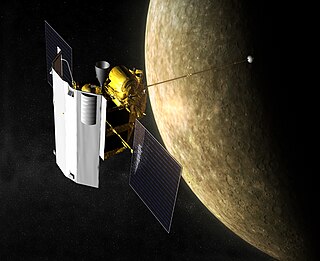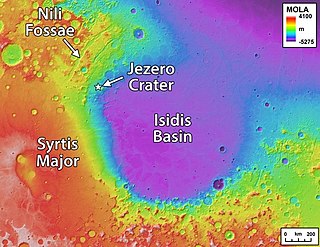Related Research Articles

The Moon is an astronomical body orbiting Earth and is the planet's only natural satellite. It is the fifth-largest satellite in the Solar System, and by far the largest among planetary satellites relative to the size of the planet that it orbits. The Moon is, after Jupiter's satellite Io, the second-densest satellite in the Solar System among those whose densities are known.

Vesta is one of the largest objects in the asteroid belt, with a mean diameter of 525 kilometres (326 mi). It was discovered by the German astronomer Heinrich Wilhelm Matthias Olbers on 29 March 1807 and is named after Vesta, the virgin goddess of home and hearth from Roman mythology.

Glasford is a village in Peoria County, Illinois, United States. The population was 1,022 at the 2010 census. Glasford is part of the Peoria, Illinois Metropolitan Statistical Area.

Manson is a city in Calhoun County, Iowa, United States. The population was 1,690 at the 2010 census.

Dione is a moon of Saturn. It was discovered by Italian astronomer Giovanni Domenico Cassini in 1684. It is named after the Titaness Dione of Greek mythology. It is also designated Saturn IV.

MESSENGER was a NASA robotic spacecraft that orbited the planet Mercury between 2011 and 2015, studying Mercury's chemical composition, geology, and magnetic field. The name is a backronym for "MErcury Surface, Space ENvironment, GEochemistry, and Ranging", and a reference to the messenger god Mercury from Roman mythology.

Tempel 1 is a periodic Jupiter-family comet discovered by Wilhelm Tempel in 1867. It completes an orbit of the Sun every 5.5 years. Tempel 1 was the target of the Deep Impact space mission, which photographed a deliberate high-speed impact upon the comet in 2005. It was re-visited by the Stardust spacecraft on February 14, 2011 and came back to perihelion in August 2016.

Aristarchus, named after the Greek astronomer Aristarchus of Samos, is a prominent lunar impact crater that lies in the northwest part of the Moon's near side. It is considered the brightest of the large formations on the lunar surface, with an albedo nearly double that of most lunar features. The feature is bright enough to be visible to the naked eye, and displays unusually bright features when viewed through a large telescope. It is also readily identified when most of the lunar surface is illuminated by earthshine. The crater is deeper than the Grand Canyon.

Sibu is an inland town in the central region of Sarawak. It is the capital of Sibu District in Sibu Division, Sarawak, Malaysia. The town is located on the island of Borneo and covers an area of 129.5 square kilometres (50.0 sq mi). It is located at the confluence of the Rajang and Igan Rivers, some 60 kilometres from the South China Sea and approximately 191.5 kilometres (119 mi) north-east of the state capital Kuching. Sibu is mainly populated by people of Chinese descent, mainly from Fuzhou. Other ethnic groups such as Melanau, Malay, and Iban are also present, but unlike other regions of Sarawak, they are not as significant. The town population as of 2010 is 162,676.

Herschel is a large crater in the leading hemisphere of the Saturnian moon Mimas, on the equator at 100° longitude. It is named after the 18th-century astronomer William Herschel, who discovered Mimas in 1789. Herschel is the second-largest crater relative to its parent body of any equilibrium planetary moon in the Solar System after Tethys's crater Odysseus. It is so large that astronomers have expressed surprise that Mimas was not shattered by the impact that caused it. It measures 139 kilometres across, almost one third the diameter of Mimas. Its walls are approximately 5 km (3 mi) high, parts of its floor are 10–12 km (6–7 mi) deep, and its central peak rises 6–8 km above the crater floor. If there were a crater of an equivalent scale on Earth it would be over 4,000 km (2,500 mi) in diameter – wider than Canada – with walls over 200 km (120 mi) high. The impact that formed Herschel must have nearly disrupted Mimas entirely. Chasmata that may be stress fractures due to shock waves from the impact traveling through it and focusing there can be seen on the opposite side of Mimas. The impact is also suspected of having something to do with the current "Pac-Man"–shaped temperature pattern on Mimas. Herschel has an estimated age of around 4.1 billion years.

The Rajang River is a river in Sarawak, Malaysia. The river is located in northwest of Borneo. The river originates in the Iran Mountains, flows through Kapit, and then towards the South China Sea. At approximately 565 km long (351 mi) of total length, it is the 4th longest river in Borneo, and the longest river in Malaysia.

Sibu Airport is an airport located 23 km (14 mi) east south east of Sibu, a town in the state of Sarawak in Malaysia. In 2018, the airport handled 1,579,528 passengers on 20,869 flights and also handled 1,443 metric tonnes of cargo. The airport is the 11th busiest airport in Malaysia, and the 3rd busiest in Sarawak in terms of passengers handled.

Koga is an impact crater on Mars, approximately 19 kilometers in diameter. It is located at 29.3°S, 103.8°W, north of the crater Virrat and northeast of the crater Dinorwic. To the north is the crater Nhill. It is named after a town in Tanzania, and its name was approved by the International Astronomical Union in 1991. According to a surface age map of Mars based on US Geological Survey data, the area around Koga is from the Noachian epoch, which places the area's age at 3.8 to 3.5 billion years ago. Sharp blocks and cliffs poke through a mantle of fine material located at the bottom of the crater. At the deepest part of the crater, it is about 5,200 meters in elevation above zero altitude, and its rim averages about 6,400 meters above zero altitude. It is therefore approximately 1.2 kilometers deep.

Jezero is a crater on Mars located at 18.38°N 77.58°E in the Syrtis Major quadrangle. The diameter of the crater is about 49.0 km (30.4 mi). Thought to have once been flooded with water, the crater contains a fan-delta deposit rich in clays. The lake in the crater was present when valley networks were forming on Mars. Besides having a delta, the crater shows point bars and inverted channels. From a study of the delta and channels, it was concluded that the lake inside the crater probably formed during a period when there was continual surface runoff.

Gale is a crater, and probable dry lake, on Mars near the northwestern part of the Aeolis quadrangle at 5.4°S 137.8°E. It is 154 km (96 mi) in diameter and estimated to be about 3.5-3.8 billion years old. The crater was named after Walter Frederick Gale, an amateur astronomer from Sydney, Australia, who observed Mars in the late 19th century. Aeolis Mons is a mountain in the center of Gale and rises 5.5 km (18,000 ft) high. Aeolis Palus is the plain between the northern wall of Gale and the northern foothills of Aeolis Mons. Peace Vallis, a nearby outflow channel, 'flows' down from the hills to the Aeolis Palus below and seems to have been carved by flowing water. Several lines of evidence suggest that a lake existed inside Gale shortly after the formation of the crater.
The Sibu by-election, 2010 was a by-election for the seat of Sibu in the Parliament of Malaysia. The Sarawak-based seat fell vacant after the death of its incumbent member, Robert Lau Hoi Chew, from liver cancer on 9 April 2010. The seat was defended for the Barisan Nasional coalition government by Robert Lau Hui Yew of the Sarawak United Peoples' Party (SUPP), while Sarawak State Assemblyman Wong Ho Leng contested the poll for the Democratic Action Party (DAP) in the Pakatan Rakyat opposition coalition. Wong won the election by 398 votes, wresting the seat from the Barisan Nasional.

Wong Ho Leng was a Malaysian politician. He was the opposition leader of the Sarawak State Assembly from May 2006 to June 2013. He was also the state chairman of the Democratic Action Party (DAP) from 2001 until 10 June 2013. He was the Member of the State Legislative Assembly of Sarawak for the seat of Bukit Assek until his death on 21 June 2014.
Sibu District is an administrative district in Sibu Division, Sarawak, Malaysia covering a total area of 2229.8 km2. It can be divided into Sibu Town area (129.5 km2) and the rural areas (2,100.3 km2). The satellite township of Sibu Jaya is included in the rural areas. Sibu District is under the purview of Sibu District Office located at Sibu Islamic Complex, Sibu Town. There are currently two local authorities namely Sibu Municipal Council (SMC) and Sibu Rural District Council (SRDC) that administers Sibu Town and Sibu rural areas respectively.
The COVID-19 pandemic was confirmed to have reached the state of Sarawak, Malaysia in March 2020. As of 21 August 2020, there are 687 confirmed cases.
References
- ↑ "Sibu crater" . Retrieved 2011-02-18.
- 1 2 "Sibu". USGS Gazetteer of Planetary Nomenclature. 2010-11-17. Retrieved 2011-02-18.
| This article about the planet Mars or its moons is a stub. You can help Wikipedia by expanding it. |
| This article about an extraterrestrial geological feature is a stub. You can help Wikipedia by expanding it. |